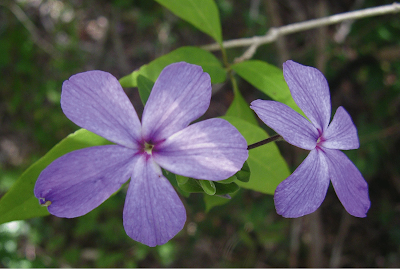[Most Recent Entries] [Calendar View]
Wednesday, January 8th, 2025
| Time | Event | ||||
| 1:34a | [Botany • 2024] Fritillaria arzuae (Liliaceae) • A New Species from Turkey
Abstract Fritillaria arzuae Tel (Liliaceae) is described as a new species from the Adıyaman Province, Turkey. It is endemic to the region and was found growing on slopes in stony areas at 1200 m a.s.l. The new species morphologically resembles F. carica and F. serpenticola. It differs from the former mainly by having a lanceolate, narrowly campanulate, yellow or sometimes reddish and smaller perigon, and from the latter by having a single leaf on the top of the stems. The pollen and seed micromorphology were studied by SEM. The conservation status was assessed to be Critically Endangered (CR). Fritillaria arzuae Tel Ahmet Zafer Tel. 2024. Fritillaria arzuae (Liliaceae), a New Species from Turkey. Annales Botanici Fennici. 61(1):289-296. DOI: doi.org/10.5735/085.061.0140 facebook.com/IgdirUniversite/posts/1027153572761223 | ||||
| 5:37a | [Herpetology • 2024] Cyrtodactylus belanegara • Another New Bent-Toed Gecko of the Cyrtodactylus marmoratus Group (Reptilia: Gekkonidae) from West Java, Indonesia
ABSTRACT We describe a new species of Cyrtodactylus from Sentul, a suburb of Bogor City, West Java, Indonesia that belongs to the C. marmoratus species group. The new species is the fourth Cyrtodactylus reported from Java. It is small (SVL 46.3–53.8 mm) and nocturnal. A combination of the following characteristics distinguishes the new species from all other congeners: supralabials 11–13; infralabials 9–11; tubercles on the dorsal surface of upper arm absent; tubercles on ventrolateral body folds present; longitudinal dorsal tubercle rows 18–20; paravertebral tubercles 27–34; ventral scale rows 37–40 at midbody; grooved precloacal depression in males; enlarged precloacofemoral scales present, containing 12 or 13 precloacal pores and 2–4 femoral pores; separated by 5–7 normal scales; subdigital lamellae on fourth toe 18–23; and enlarged transverse median subcaudals absent. The new species is genetically divergent from the other two Javan congeners of the C. marmoratus group—C. marmoratus and C. semiadii—with genetic divergences (p-distances) of 21.3–22.3% in the mitochondrial ND2 gene. Cyrtodactylus belanegara sp. nov. Etymology: The specific epithet is a compound noun in apposition and refers to belanegara (in the Indonesian language), composed with the adjective ‘‘bela’’ (= defending) and the noun ‘‘negara’’ (= country). The name refers to the mission of the Indonesia Defense University, where the new species has been found. English name: Defending Bent-toad Gecko Indonesian (local) name: Cecak Jarilengkung belanegara Awal Riyanto; Isna A. Hikmah; A.A. Thasun Amarasinghe; A. Abinawanto and Amir Hamidy. 2024. Another New Bent-Toed Gecko of the Cyrtodactylus marmoratus Group (Reptilia: Gekkonidae) from West Java, Indonesia. Herpetologica. 80(4); 358–367. DOI: doi.org/10.1655/Herpetologica-D-24-00023 | ||||
| 10:09a | [Botany • 2025] Begonia butuanensis (Begoniaceae, sect. Baryandra) • Morpho-anatomical Description of New Begonia Species from Butuan City, Mindanao Island, Philippines Abstract Begonia butuanensis, a new species of Begonia sect. Baryandra endemic in northeastern Mindanao is described. We compared it to another species endemic to southern Mindanao, B. copelandii. Both species have ciliate leaf margins, rounded outer tepals, and lanceolate inner tepals of staminate flowers. However, B. butuanensis is distinct in its smaller perianth size, triangular capsule lateral wing with subfalcate apex (vs. rectangular with subacute to truncate apex in B. copelandii), puberulous peduncles (vs. glabrous), and orbicular to slightly ovate lamina with rounded to obtuse apices (vs. ovate to orbicular lamina with obtuse to acuminate apex). The species is observed only from the type locality, and we recommend the species to be listed as Critically Endangered (CR) following the 2024 IUCN guidelines. archipelago, Begoniaceae, big genera, Pleistocene Aggregate Island Complexes, Eudicots
Begonia butuanensis Bucay, Tandang & K.F.Chung, sp. nov. § Baryandra Type:—PHILIPPINES. Mindanao, Province of Agusan del Norte, western portion of Butuan City, ..., ca. 65 masl, 15 August 2023, MAC Bucay & DN Tandang 0981 (holotype PNH, isotype HAST). Diagnosis:—Begonia butuanensis was found in northern portion of Mindanao but resembles another Mindanao-endemic species, B.
copelandii found only in Mt. Apo, southern portion of the island. Both species have ciliated hairs in the leaf margins and abaxial
venation. Main difference is on the perianth size as B. butuanensis is comparatively smaller than that of B. copelandii’s distinct
big flowers. B. butuanensis also differs significantly on capsule’s lateral wing by having triangular shape with subfalcate apex (vs
rectangular with subacute to truncated apex), puberulous peduncles (vs glabrous), and generally orbicular to slightly ovate lamina
with rounded to obtuse apices (vs ovate with obtuse to acuminate apices). Etymology:—The specific epithet, “butuanensis” is derived from the type locality, Butuan City, province of Agusan del Norte, Mindanao island. Mark Angelo C. BUCAY, Danilo N. TANDANG, Hong-Wun CHEN, Rosario R. RUBITE, Kuo-Fang CHUNG. 2025. Morpho-anatomical Description of New Begonia Species (sect. Baryandra, Begoniaceae) from Butuan City, Mindanao Island, Philippines. Phytotaxa. 681(1); 102-108. DOI: doi.org/10.11646/phytotaxa.681.1.8 | ||||
| 3:09p | [Botany • 2025] Stenandriopsis darainensis (Acanthaceae) • A New Species and a new combination in Stenandriopsis from Madagascar
Summary A new species of the palaeotropical genus Stenandriopsis S.Moore (Acanthaceae) is described from Daraina region (Loky-Manambato) in northeastern Madagascar, and named S. darainensis I.Darbysh. & Callm. It is compared to the most similar species morphologically, S. boivinii (S.Moore) Benoist, and notes on its habitat preferences and conservation status (extinction risk) are provided — it is assessed using IUCN criteria as Vulnerable [VU D2]. In addition, Stenandriopsis leptostachys Benoist var. longifolia Benoist from southern Madagascar is re-elevated to full species status and a new combination in Stenandriopsis is made for this taxon, Stenandriopsis longifolia (Benoist) I.Darbysh. & Callm. Key Words: Acantheae, endemic, IUCN Red List assessment, novelty, taxonomy
Iain Darbyshire, Martin W. Callmander and Nomentsoa J. E. Randriamamonjy. 2025. A New Species and a new combination in Stenandriopsis (Acanthaceae) from Madagascar. Kew Bulletin. DOI: doi.org/10.1007/s12225-024-10246-9 |
| << Previous Day |
2025/01/08 [Calendar] |
Next Day >> |












